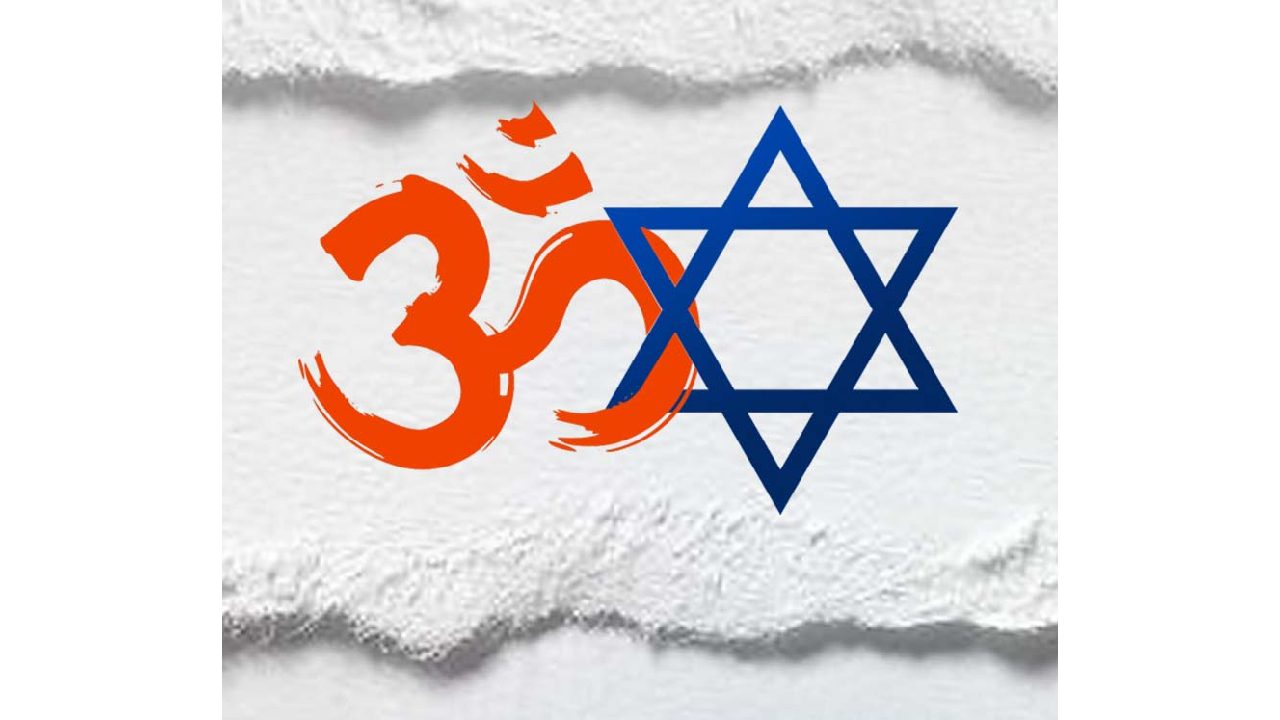- Dr. Nathan Katz, a distinguished scholar of Indic studies, discusses his academic journey, extensive contributions to Indo-Judaic studies, and his experiences in India.
- Highlighting the harmonious coexistence of Jews in India, Katz recounts his experiences with the Jewish community in Kochi, emphasizing their dual identity as proud Jews and Indians, and the acceptance and lack of anti-Semitism they experienced.
- Katz elaborates on the similarities and differences between old religions like Hinduism and Judaism and newer, more missionary-oriented religions, discussing their respective approaches to spirituality, tradition, and proselytization.
- Katz reflects on India’s long-standing tradition of welcoming and integrating diverse religious and cultural communities, contrasting it with the history of persecution faced by Jews in Europe and emphasizing the importance of mutual respect and understanding between different faiths.
Dr. Nathan Katz is a distinguished professor emeritus at Florida International University. He also served as the Bhagwan Mahaveer Professor of Jain Studies, Director of Jewish Studies, and founding Chair of the Department of Religious Studies. Born in Philadelphia and raised in Camden, New Jersey, Nathan earned his BA from Temple University in 1970. He spent two years in India studying classical languages before returning to Temple for graduate studies in religion. He was a Fulbright dissertation fellow in Sri Lanka and India from 1976 to 1978 and received his PhD in 1979.
Nathan has taught at many prestigious schools, ultimately joining Florida International University, where he started the Department of Religious Studies. He also helped launch programs in Jewish Studies, Asian Studies, Gender JAIN Studies, and the Study of Spirituality. He is best known for his work in Indo-Judaic Studies and has written several books on the subject. Nathan has also been an adjunct professor of Hinduism at the Hindu University of America and taught at the Sivananda Yoga Ashram in the Bahamas. Currently, he is the Dean of CYS College of Jewish Studies.
Nathan has received numerous awards and accolades, including being a finalist for ‘Who Are The Jews of India?’ and winning the 2004 Vyasa Award from Bhartiya Vidya Bhavan Vak Devi Saraswati Award from India. He received the President’s Award for Achievement and Excellence and Florida International University’s Faculty Senate Awards for Research and Service. He was named Scholar of the Year by the University of South Florida in 1992.
Nathan, your accomplishments are nothing short of impressive, and I’m truly envious of your resume. How did you ever find the time to do all this?
Now that I’m retired, I can’t imagine how I did it either. (laughter)
You must have been a busy person! Please tell us a bit about your background, particularly your growing up years? Were there any people or events that influenced your worldview? How did you become interested in Indic civilization?
When I was five years old, during a family dinner, I suddenly announced that I would go to India at my first chance. I don’t remember why I said it, but it was something my mother told me I declared. This curiosity about India might have started with our neighbor at our summer cabin, a Hindu renunciate man named Yubal Cambell, who studied under Swami Yukteswarananda at the Ramakrishna Mission in Philadelphia. He was intriguing and fun, playing games with us kids and showing us his unique traditions, like being a vegetarian, which was new to me.

As I grew older, my interest in Asian cultures deepened. During the 1960s, many young Americans, including myself, were drawn to Asian spirituality. This led me to major in English literature at Temple University and pursue a minor in its excellent religion department. I learned from teachers who were not only scholars but also practitioners of their faiths, like a Korean Zen monk and disciples of Sri Aurobindo.
This experience shaped my academic career. When I later established the Department of Religion at Florida International University, I focused on hiring faculty who were deeply rooted in their traditions, not just academically but spiritually. This approach helped us build a strong and respected department. My early encounters and continuous education contributed significantly to my understanding and appreciation of Indian spirituality and culture.
You’ve spent considerable time in India studying and later teaching its various religions. I’m particularly interested in your work on the Jews of India. Given the small size of the Jewish community there, what did you learn about their experiences living in a largely Hindu-majority society?
As I mentioned earlier, my academic background includes training in Pali, Sanskrit, Tibetan, and the textual traditions of South Asia. During a sabbatical in Sri Lanka, I was deeply involved in studying Buddhist monasticism. After completing my work there, I discussed with my wife the possibility of visiting Kochi in Southern India, as I had heard of the old Jewish community residing there. This was in 1983. Our decision was to explore Kochi and then travel around India for a few months before returning home.
Upon arriving in Kochi, we visited the local synagogue and began conversing with the people we met there. This experience was profoundly heartwarming, leading to instant friendships. What struck me most profoundly was the dual identity of the Jews in Kochi; they were immensely proud both of their Jewish heritage and their Indian nationality. This dual pride reminded me of my own identities as a proud Jew and an American. Unlike the backdrop of my upbringing in America, where the Holocaust was a constant, somber presence, the Jews in Kochi exhibited none of the defensive postures typical of those raised with such a traumatic legacy. In India, being Jewish was celebrated openly and without reservation, which was incredibly refreshing and enlightening for me.
The Jews of Kochi had seamlessly integrated into Indian society. I learned that anti-Semitism was virtually unknown in their community—a stark contrast to the experiences of Jews elsewhere. The Jewish community in Kochi was multilingual and well-versed in their religious traditions, speaking Hebrew, a form of Ladino, Malayalam, and often Hindi, which was more practical for their daily interactions across India.
One evening, we were invited to the home of Elias Koder, a leader in the local Jewish community. The gathering he hosted was termed a “drinking club,” where friends from diverse backgrounds convened around a large table, sharing food and drinks in a convivial atmosphere. This group included not only Jews but also Zoroastrians, referred to affectionately as ‘Parsi Jews’ due to their close association with the Jewish community and even the president of the local Jain temple. The Jain’s presence was particularly notable as he often brought snacks that everyone could eat, respecting the dietary restrictions prevalent among the different faiths. This inclusiveness extended to Hindu and Muslim neighbors as well, reflecting a microcosm of Kerala’s diverse social tapestry.
This communal harmony was emblematic of what many locals referred to as “God’s own country,” a place where such peaceful coexistence wasn’t just rare but was the norm. During our time in Kochi, it became clear that this was a community where differences were celebrated and mutual respect was commonplace.
The friendships and interactions within this community were profound, illustrating a society where religious and cultural boundaries were transcended as a routine matter. It was a powerful example of how communities could live together in peace despite deep religious differences. This experience in Kochi not only enriched my understanding but also inspired several books I later wrote about the region and its unique Jewish community.
Living among the Jews of Kochi showed me a different way of experiencing Jewish identity—one not overshadowed by the trauma of the Holocaust but illuminated by the richness of peaceful coexistence and cultural integration. This profound experience reshaped my understanding of religious coexistence and has stayed with me as a cornerstone of my academic and personal reflections on the potential for harmony in diverse societies.
Given your extensive knowledge of India’s religions, including Jainism, Hinduism, Buddhism, and Judaism, could you summarize the main similarities and significant differences among these religions?
We often focus too much on the differences between religions while overlooking their important similarities. This tendency might stem from the conventional division of religions into Abrahamic (like Judaism, Christianity, and Islam) and Dharmic (such as Hinduism, Buddhism, Jainism, and Sikhism) or into Eastern and Western religious traditions. But I believe there’s another way to understand the world’s religions by categorizing them as either “old” or “new” religions.
Let’s consider Hinduism and Judaism as examples of old religions. These faiths share many common elements, particularly in their concerns for ritual purity, dietary laws, and the sanctity of specific places. For instance, both traditions emphasize the importance of water in purification rituals—Hindus have their temple tanks, and Jews have the mikvah, pools of natural water used for ritual immersion. Dietary rules are central, too, with Jews following kosher laws and many Hindus practicing vegetarianism, which reflects their respect for life.
Old religions also place great importance on specific locations. In Hinduism, certain sites like Varanasi or Mount Kailash are irreplaceable for performing specific rituals. Similarly, for Jews, Jerusalem and specifically the Temple Mount hold unparalleled spiritual significance. The attachment to these places isn’t just about the physical locations but about their deep historical and spiritual connections to the faith. This has been a source of both strength and vulnerability, as neither Hindus nor Jews have always had control over these sacred places.
In contrast, new religions, which emerged from these older traditions, often have a more universal approach to where worship and practice can occur. Buddhism and Islam, for example, do not require adherence to a specific geographic location. These religions also tend to be more missionary, actively seeking to convert others, which is a stark contrast to the more localized and non-proselytizing nature of old religions.
These newer religions can be practiced almost anywhere and often adapt to local cultures and societies as they spread, which has helped them grow. Christianity and Islam, for example, are practiced worldwide and adapt their practices to fit various cultures, which might involve converting people from other faiths.
However, the local nature of old religions like Judaism and Hinduism means that they are deeply intertwined with the histories and cultures of specific places. For Jews, Israel is not just a country but the historical and spiritual home of the Jewish people. For Hindus, the land of Bharat (India) is not just a piece of earth but a sacred geography imbued with spirituality and tradition.
This connection to a place has significant implications. It means that these religions are not just about beliefs or practices but are also about maintaining a continuous link with a tradition that is rooted in a particular land and culture. It’s not simply about faith; it’s also about identity, history, and the continuity of a community.
The distinctions between old and new religions bring out a crucial aspect of how religions interact with the world. While new religions may adapt and spread across the globe, old religions often act as keepers of tradition, maintaining practices that have been passed down through generations and are tied to specific geographical areas. This has both preserved their traditions and posed challenges, especially when followers are dispersed or when their sacred sites are under the control of others.
This distinction has led to a mutual appreciation between Jews and Hindus. Both communities value the integrity of their traditions and the non-proselytizing aspect of their faiths, which respects the religious boundaries of others. This respect is crucial in a world where religious conversion can lead to cultural erosion and familial strife.
In summary, while new religions have the flexibility of being practiced anywhere, appealing to a global audience, and actively seeking new adherents, old religions like Hinduism and Judaism offer a deep, unbroken connection to their historical and spiritual pasts. This connection enriches their followers’ lives and provides a sense of belonging and continuity that is rare and profound. These characteristics highlight the depth and diversity of religious experiences across the globe, showing that while all religions seek to answer life’s big questions, they do so in uniquely meaningful ways.
That’s a very unique and clear exposition of the similarities and differences. We should also add the spiritual aspect, the focus on family, and the emphasis on knowledge. These are important similarities between Hinduism and Judaism.
Now, given India’s history of welcoming repressed people from all over the world, including Jews, Christians, Parsis, and even Polish refugees during WWII, how do you think these diverse groups have been received and integrated into Indian society?
Discussing the broader aspect of inclusiveness within Indian society, it’s notable that India has historically been a sanctuary for oppressed communities worldwide. This extends well beyond Jewish refugees; for instance, one of the oldest Christian churches can be found in Southern India. Additionally, the Parsis, who were expelled from Iran in the 8th century, and the Bahá’ís, fleeing persecution 200 years ago, found refuge and respect in India. During the Second World War, India also warmly welcomed a contingent of Polish refugees. These examples highlight a consistent pattern of acceptance and integration that characterizes Indian society.
From my perspective, the harmonious integration of these communities, including Jews, can partly be attributed to their relatively small numbers, which perhaps made assimilation smoother. Both historically and in contemporary times, these groups have contributed significantly to Indian society, not only culturally but also through trade and commerce, enhancing prosperity in their adopted homeland.
For Jews, our historical narrative in India has been profoundly positive. Whether in Mumbai or Kochi, Jewish communities have thrived under the benevolent acceptance of local leaders and the broader community. This acceptance is reflected in the stories of Jews and Parsis arriving by ship and being warmly greeted by local rulers.
The story of the Tibetan refugees is another poignant example. Like the Jews and Parsis, Tibetans have received governmental support and have generally attained a higher standard of living than the average Indian citizen, all without invoking jealousy or resentment.
In my latest book, “Jews and India,” I explore the deep, mutual influences between Jews and Indians over two millennia. It’s fascinating to see how, despite our small numbers, the Jewish community has significantly impacted Indian society. Many Jews who fled the Holocaust found not only refuge in India but also a new spiritual path. Some of them became prominent Swamis, Buddhist monks, or nuns, contributing to the spiritual life of India and, in turn, influencing the development of Buddhism globally.

Furthermore, the women’s movement, which originated in the West, found a different expression in India. Jewish women, along with their Indian counterparts, have played critical roles in advancing women’s rights and education within various religious communities. This cross-cultural exchange has enriched both societies, showcasing the dynamic ways in which minority communities can influence a larger host culture.
Overall, the Jewish experience in India exemplifies how inclusiveness and open-mindedness in a society can lead to profound and mutually beneficial relationships. India’s history of accepting and integrating diverse communities speaks volumes about its cultural ethos and provides a model of tolerance and pluralism that the world can learn from.
And, then, we have Europe’s long history of widespread discrimination against Jews and Roma people. What’s your take on this sharp contrast between the Indian and European reception of the oppressed people?
Growing up, I always dreamed of visiting distant lands like India and Africa; Europe, however, never featured on my travel list. My infrequent visits to Europe were professional obligations rather than personal choices. Despite its undeniable beauty, from the magnificent architecture to the exquisite arts and delicious food, Europe always evoked mixed feelings for me.
The dark undertones of Europe’s history, especially its treatment of Jews, cast a long shadow over its aesthetic charms. My own family’s history is a testament to this. Long before the Holocaust, my father fled Ukraine during the Russian Revolution due to the violent anti-Semitism that pervaded Europe—not just from the Nazis but from wider society. This history of persecution deeply influenced my reluctance to connect with Europe.
A few years ago, I did visit Tuscany, Italy, with my wife. It’s undeniably one of the most beautiful places I’ve ever seen, with its rich history, stunning art, and grand buildings. Yet, even in such a picturesque setting, I couldn’t shake off a sense of historical weight. During a Sabbath visit to one of Florence’s famed synagogues, I was reminded of the darker chapters of its past. During World War II, as American forces advanced through Italy, Italian fascists attempted to burn down this beautiful synagogue—not out of a rejection of its aesthetics, but out of spite and hatred towards the Jewish community. It was Italian partisans, opposed to fascism, who ultimately saved the building. They perhaps acted not out of love for the Jewish people but out of respect for the synagogue’s artistic value.
Contrast this with my experiences in India, where Jews have historically been welcomed with open arms and treated with warmth and respect akin to family. In India, Jews have enjoyed privileges and acceptance, often feeling more like honored guests than wary refugees. The difference in my experiences in Europe and India is stark: one marked by historical trauma and the other by an embracing warmth.
My time in India spans years, filled with positive interactions and a deep sense of belonging, whereas my visits to Europe are counted in mere months, laden with historical burdens. This profound disparity in my experiences shapes my view of both these worlds.



![[ Nbc News ] Barbie debuts its first ‘Diwali doll’ ahead of the Hindu festival of lights](https://hinduvishwa.org/wp-content/uploads/2024/10/241003-diwali-barbie-vl-404p-55c7df-75x75.webp)
![[ India Today ] Ohio senator JD Vance thanks wife, a Hindu, for helping him find Christian faith](https://hinduvishwa.org/wp-content/uploads/2024/06/us-senator-jd-vance-reveals-how-his-hindu-wife-usha-helped-him-find-his-christian-faith-image-re-272530504-16x9_0-120x86.webp)










